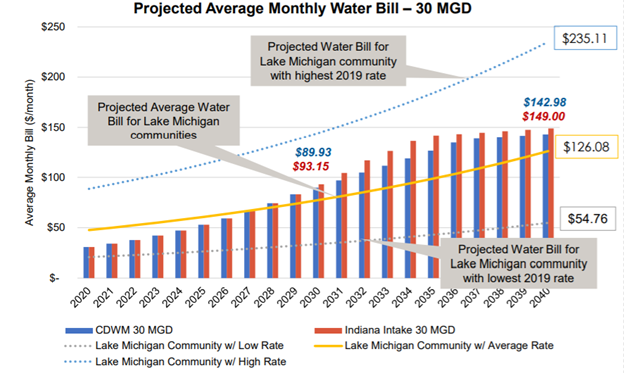The city of Joliet (“City”), the fourth largest city in Illinois, has decided to secure its drinking water from Chicago instead of Hammond, Indiana.[i] Joliet has historically been dependent on groundwater, pumping from the Ironton Galesville aquifer at an unsustainable rate.[ii] The City has known since the 1960s that the pumping rate exceeds the rate of recharge into the aquifer.[iii] Estimates show the aquifer will likely run dry by the year 2030, forcing the City to seek out alternatives.[iv]
Joliet examined fourteen alternative water sources in Phase I of its exploration.[v] During Phase II, five sources were studied in more detail to replace the existing water source in Joliet, including several municipal Lake Michigan intake systems and the Kankakee and Illinois Rivers.
In January 2020, the Joliet City Council selected Lake Michigan as the water source,[vi] and, in late January of this year, chose the Chicago Department of Water Management’s (CDWM) system over constructing a new intake system to obtain treated water from Hammond.[vii]
The eight city council members were faced with two options:
- The New Indiana Intake (Hammond) alternative: This alternative consists of construction of a new raw water intake along the Indiana shoreline with pumping capacity capable of transmitting the water to Joliet for treatment and distribution.[viii]
- Pros:
- A state-of-the-art advanced water treatment plant, capable of handling emerging contaminants;
- No cost to purchase water – the City of Chicago alternative will be able to charge Joliet whatever rate it wants;
- Complete control over design, construction, transmission and management of its water;
- Greater resiliency and reliability coming from a new system under Joliet’s complete control;
- Ability to sell and profit from treated water to other communities in the area that remain dependent on the Ironton Galesville aquifer that will also eventually need a new source of water.
- Cons:
- Greater capital costs ($1.03 billion to $1.37 billion);
- Responsibility and liability of the project and management of water would be placed solely on Joliet.
- Pros:
- CDWM alternative: This alternative consists of purchasing water from the City of Chicago and constructing pumping and water mains to distribute the water.[ix]
- Pros:
- Lower capital costs ($592 million to $810 million);
- Responsibility and liability of the project and management of water would mostly fall on the city of Chicago.
- Cons
- The city of Chicago will control purchased water costs and dictate those costs on a whim;
- Less or no ability to sell water to surrounding communities;
- Water sourced from an aging water treatment plant built in 1930 that will require updates;
- Pros:
Ultimately, had Joliet chosen the New Indiana Intake alternative, it would “have greater control over factors related to the implementation, operation, and cost of its treated water supply.”[x] The CDWM alternative, on the other hand, requires less infrastructure, resulting in a lower debt burden for the City. But Joliet would be a long-term customer of the City of Chicago and subject to changes in the cost of service.[xi]

Source: Alternative Comparison Summary: Alternative Water Source Program, Rethink Water Joliet, https://db3eaa5b-627b-4351-a0d6-a59bfce6a4d6.filesusr.com/ugd/3961f7_9e4e556703aa49329571fe2b87cf7953.pdf (Last visited Feb. 10, 2021).
—
In the short-term, water rate increases are slightly lower with the CDWM. However, the savings provided by a CDWM approach are less because economies of scale (a proportionate saving in costs gained by an increased level of production) do not apply to costs for the purchase of water from Chicago—Joliet will never be able to produce water in the CDWM scenario.[xii] And the CDWM alternative is vulnerable to price increases.[xiii]
In the end, Joliet chose the CDWM alternative over the New Indiana Intake alternative even though the latter would have provided greater control, likely better water quality, a potential source of revenue, greater resiliency, fewer long-term savings, and no fluctuation in water rates to be dictated by Chicago.
 Source: Alternative Comparison Summary: Alternative Water Source Program, Rethink Water Joliet, https://db3eaa5b-627b-4351-a0d6-a59bfce6a4d6.filesusr.com/ugd/3961f7_9e4e556703aa49329571fe2b87cf7953.pdf (Last visited Feb. 10, 2021).
Source: Alternative Comparison Summary: Alternative Water Source Program, Rethink Water Joliet, https://db3eaa5b-627b-4351-a0d6-a59bfce6a4d6.filesusr.com/ugd/3961f7_9e4e556703aa49329571fe2b87cf7953.pdf (Last visited Feb. 10, 2021).
[i] John Ferak, Joliet Picks Chicago as Future Water Source, Patch (Jan. 28, 2021), https://patch.com/illinois/joliet/joliet-picks-chicago-future-water-source.
[ii] 2019 Joliet Drinking Water Quality Report, The City of Joliet (June 2020) https://www.joliet.gov/Home/ShowDocument?id=26006.
[iii] Id.
[iv] Decision On Joliet’s Water Supply At End Of This Year, 1340 WJOL (Jul. 17, 2019), https://www.wjol.com/decision-on-joliets-water-supply-at-end-of-this-year/#:~:text=Experts%20say%20the%20City%20of,currently%20uses%20is%20not%20sustainable.
[v] Id.
[vi] 2019 Joliet Drinking Water Quality Report, supra note 2.
[vii] Ferak, supra note 1.
[viii] Alternative Water Source Program, Rethink Water Joliet, https://www.rethinkwaterjoliet.org/alternativewatersourceprogram (Last visited Feb. 10, 2021).
[ix] Id.
[x] Alternative Comparison Summary: Alternative Water Source Program, Rethink Water Joliet, https://db3eaa5b-627b-4351-a0d6-a59bfce6a4d6.filesusr.com/ugd/3961f7_9e4e556703aa49329571fe2b87cf7953.pdf (Last visited Feb. 10, 2021).
[xi] Id.
[xii] Id.
[xiii] Alternative Water Source Program, supra note 8.

